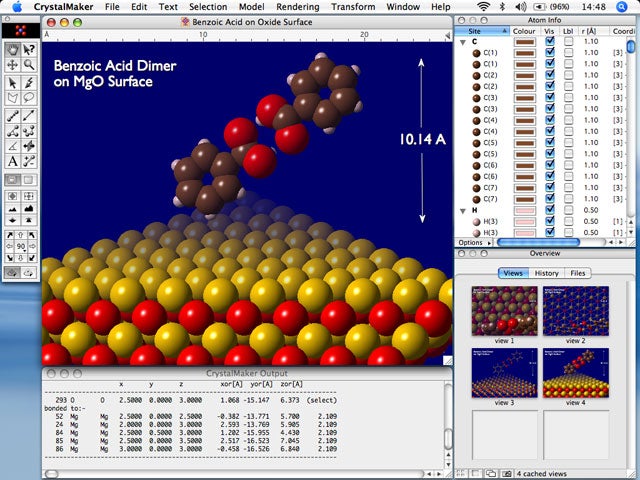

- #Viewing multiple unit cells in crystalmaker plus
- #Viewing multiple unit cells in crystalmaker series
Ringwoodite has been synthesized at conditions appropriate to the transition zone, containing up to 2.6 weight percent water. The ability of ringwoodite to incorporate hydroxide is important because of its effect on rheology. Ringwoodite in the lower half of the transition zone is inferred to play a pivotal role in mantle dynamics, and the plastic properties of ringwoodite are thought to be critical in determining flow of material in this part of the mantle.
#Viewing multiple unit cells in crystalmaker plus
The 520-km depth discontinuity is generally believed to be caused by the transition of the olivine polymorph wadsleyite (beta-phase) to ringwoodite (gamma-phase), while the 660-km depth discontinuity by the phase transformation of ringwoodite (gamma-phase) to a silicate perovskite plus magnesiowüstite. Seismic activity discontinuities at about 410 km, 520 km, and at 660 km depth have been attributed to phase changes involving olivine and its polymorphs.

In Earth's interior, olivine occurs in the upper mantle at depths less than about 410 km, and ringwoodite is inferred to be present within the transition zone from about 520 to 660 km depth. In meteorites, ringwoodite occurs in the veinlets of quenched shock-melt cutting the matrix and replacing olivine probably produced during shock metamorphism. The latter has been discovered in a natural sample only recently and was named ahrensite, in honor of US mineral physicist Thomas J.
#Viewing multiple unit cells in crystalmaker series
Natural ringwoodite generally contains much more Mg than Fe but can form a gapless solid solution series from the pure Mg endmember to the pure Fe endmember.

Natural ringwoodite has been found in many shocked chondritic meteorites, in which the ringwoodite occurs as fine-grained polycrystalline aggregates. The pressure range for stability of ringwoodite lies in the approximate range from 18 to 23 GPa. The physical and chemical property of this mineral partly determine properties of the mantle at those depths. Ringwoodite is thought to be the most abundant mineral phase in the lower part of Earth’s transition zone. Olivine is most abundant in the upper mantle, above about 410 km (250 mi) the olivine polymorphs wadsleyite and ringwoodite are thought to dominate the transition zone of the mantle, a zone present from about 410 to 660 km depth. Spinel group minerals crystallize in the isometric system with an octahedral habit. Ringwoodite is polymorphous with forsterite, Mg 2SiO 4, and has a spinel structure. The properties of these minerals determine many of the properties of the mantle. At depths greater than about 660 kilometres (410 mi), other minerals, including some with the perovskite structure, are stable. Olivine, wadsleyite, and ringwoodite are polymorphs found in the upper mantle of the earth. Ringwoodite was named after the Australian earth scientist Ted Ringwood (1930–1993), who studied polymorphic phase transitions in the common mantle minerals olivine and pyroxene at pressures equivalent to depths as great as about 600 km. This mineral was first identified in the Tenham meteorite in 1969, and is inferred to be present in large quantities in the Earth’s mantle. Ĭombined with evidence of its occurrence deep in the Earth's mantle, this suggests that there is from one to three times the world ocean's equivalent of water in the mantle transition zone from 410 to 660 km deep. In this case two hydroxide ions usually take the place of a magnesium ion and two oxide ions. Ringwoodite is notable for being able to contain hydroxide ions (oxygen and hydrogen atoms bound together) within its structure. It is polymorphous with the olivine phase forsterite (a magnesium iron silicate). Ringwoodite is a high-pressure phase of Mg 2SiO 4 (magnesium silicate) formed at high temperatures and pressures of the Earth's mantle between 525 and 660 km (326 and 410 mi) depth. Crystal (~150 micrometers across) of Fo90 composition blue ringwoodite synthesized at 20 GPa and 1200 ☌.ĭeep blue, also red, violet, or colourless (pure Mg 2SiO 4)ģ.90 (Mg 2SiO 4) 4.13 ((Mg 0.91,Fe 0.09) 2SiO 4) 4.85 (Fe 2SiO 4)


 0 kommentar(er)
0 kommentar(er)
